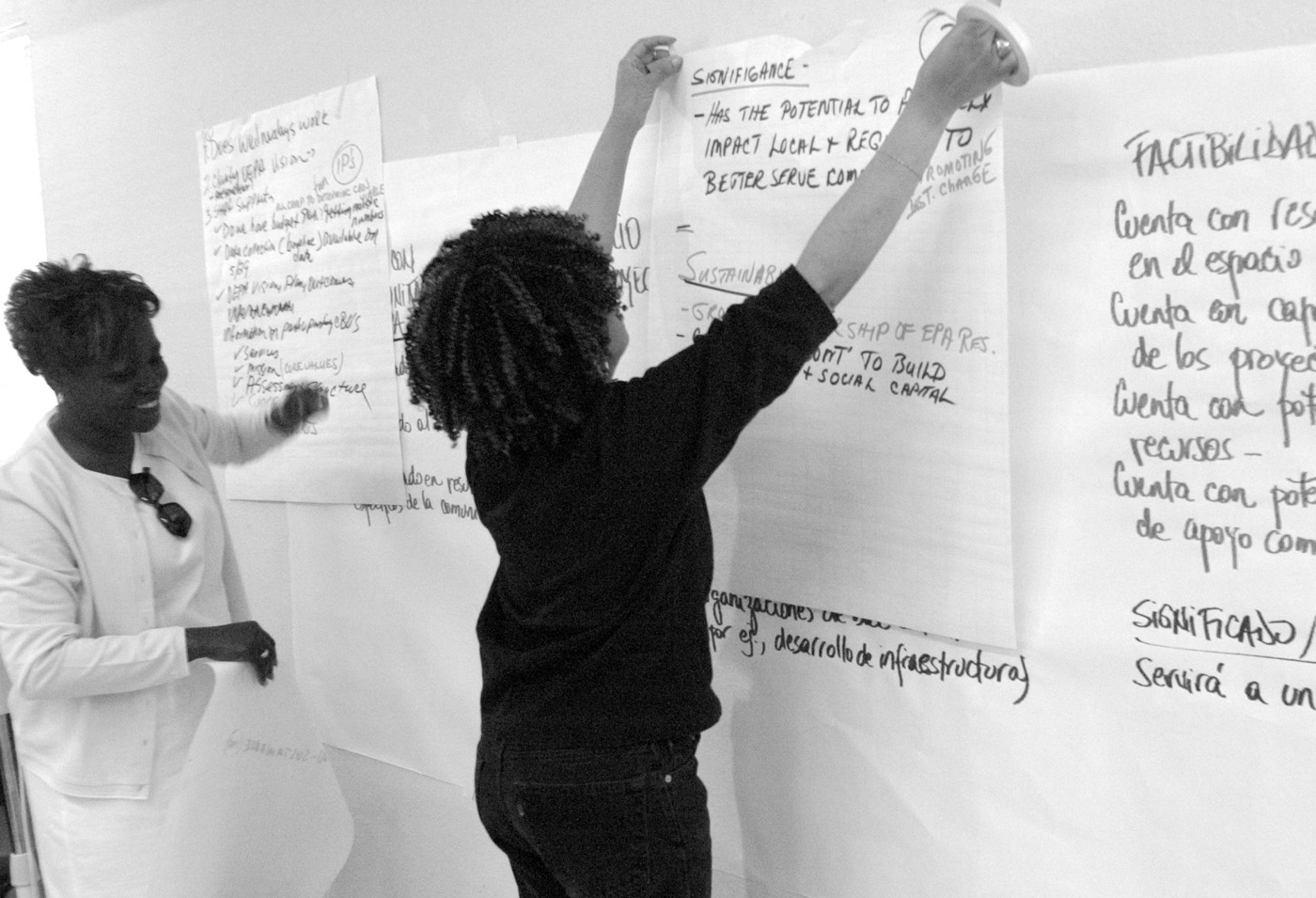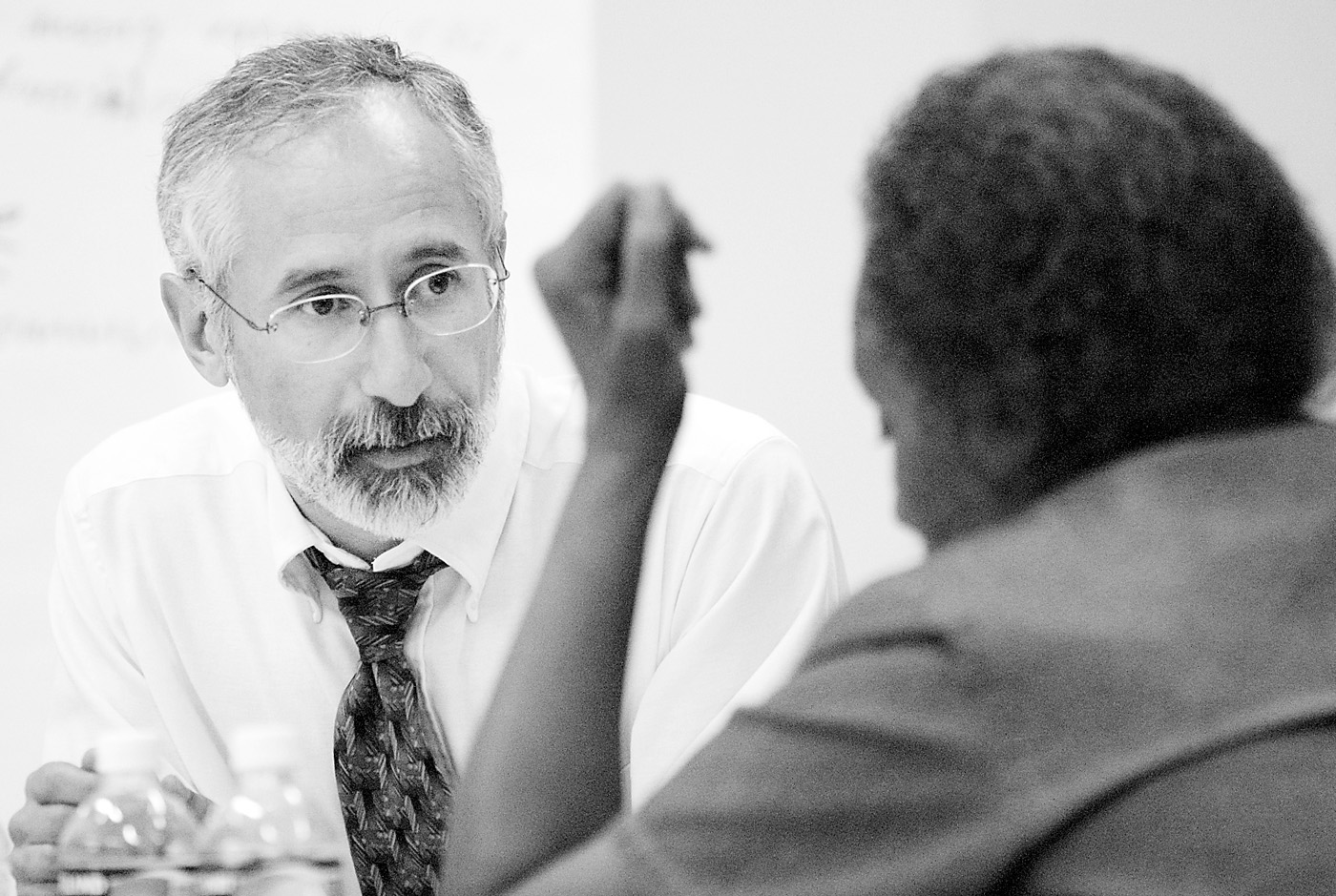
Publication Date: Wednesday, May 29, 2002
"If you educate the mom, you've educated the whole family."
Andrea Uvera - East Palo Alto resident.
Deep impact
One East Palo Alto helps residents reinvent their community
by Jennifer Deitz Berry
Talk to Andrea Uvera about the challenges she faces in her East Palo Alto neighborhood, and it quickly becomes clear why she is investing long afternoons and evenings in planning sessions that are a staple of the One East Palo Alto neighborhood revitalization initiative.
One East Palo Alto meetings: establishing priorities. (Photos by David Neville)
East Palo Alto residents work with Stanford professor David Fetterman deciding how to spend millions of dollars in grant money. (Photos by David Neville)
She recently took part in a six-hour Sunday afternoon meeting to share her views on how to target millions of dollars in grant money to improve the city. Not surprisingly, continuing efforts to improve neighborhood safety was high on her list. She has waged a personal battle with drug-dealers on her street -- attempting to scare them away by trimming back trees and installing motion-sensor outdoor lights. But the lights were smashed and her dog was killed, apparently by way of retaliation. Uvera is also eager to see more adult-education programs set up, particularly for women. "If you educate the mom, you've educated the whole family," she said.
Nozipo Wobogo, a seven-year employee of the East Palo Alto Community Law Project, also showed up at the meeting to cast a vote in favor of increasing support for community-based organizations, including making sure legal services continue to be available to local residents given uncertainty over the future of the Law Project.
One East Palo Alto is a groundbreaking initiative which its backers are determined to have succeed. It is funded and staffed by some of the biggest foundations on the Midpeninsula. The Hewlett Foundation and the Peninsula Community Foundation combined have dedicated more than $7 million to the six-year effort which began in 1999. Stanford's Haas Center for Public Service has also joined in, providing staffing and recruiting university faculty and other professionals to help inform decisions. But the primary players are the East Palo Alto residents themselves. They set the goals and priorities for spending and get projects going. The mammoth initiative has pulled together hundreds of activists eager to make a difference in their city. African Americans, Latinos and Pacific Islanders alike joined committees focused on key community concerns; among them, expanding access to technology, making neighborhoods safe and beautiful, supporting economic growth by increasing job opportunities and training for small business owners, and improving education. About 40 projects in nine focus areas have gotten underway since the project kicked off. One committee has focused on organizing residents around neighborhood revitalization efforts. They've created block clubs throughout the city, pulling neighbors together to form community watches and clean up their streets. They've also worked to strengthen ties between police and residents, asking officers to hold community meetings on domestic violence or basic safety measures like installing fire alarms or putting bars on windows. Police and fire officials also joined in a 400-person nighttime rally aimed at reclaiming the streets from drug dealers and other criminals. Meanwhile, the Health and Human Services workgroup has succeeded in setting up a training program for residents through partnerships with Foothill and Canada community colleges. Thirty East Palo Altans will receive one year of training in health services and family support, if they'll return to staff local agencies and help widen outreach efforts.
Many believe One East Palo Alto will make an impact on the city that runs deeper than any one project set up. Residents who may have been reluctant to get involved in city politics and government become active participants and leaders in their community, as well as helping break down ethnic divides that have paralyzed the city at times. Refugio Huizar said when he first got involved in the project as an outreach worker it was just a way to make some extra money. But as he circulated through the Latino community he began to recognize the challenges facing families and the lack of services for Latinos and decided to get more active, ultimately getting himself elected to the organization's 12-member advisory board. "This whole process in East Palo Alto has made Latinos and African Americans - the two biggest groups - know where the others stand and what needs to be done to change those attitudes and to include everybody," he said. "This really is a journey of discovery," said Executive Director Todd Stillwell. One East Palo Alto is testing a theory that development will be most effective when it's "by and for the people in the community," he said, "but there isn't much precedence for this approach." One East Palo Alto has now reached its halfway point - three years into the project -- and funders are calling on residents to consolidate their efforts around a handful of "signature" projects for the remaining three years. Making those decisions has been anything but easy -- an effort that has involved intense discussions over a series of evening and weekend meetings. Haas Center staff also arranged to bring in Stanford professor David Fetterman to facilitate decisionmaking efforts, using a technique he calls "empowerment evaluation" that helps residents brainstorm what they want to accomplish and set priorities. "They need to know how to start thinking in terms of, 'if I have these resources and use these processes and activities, I'll probably be able to get to this outcome and maybe even this communitywide impact,'" Fetterman said. Residents' priorities for the next three years? Focusing on education, jobs and economic development, safety and protecting the environment.
E-mail Jennifer Berry at Jenberry2@aol.com

